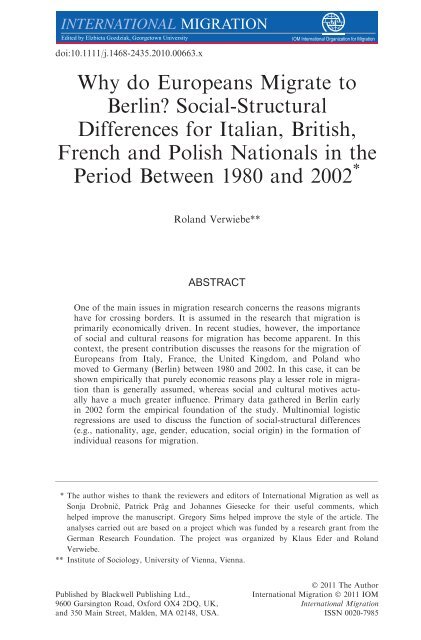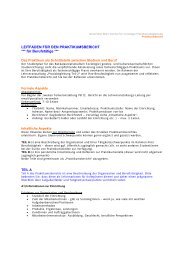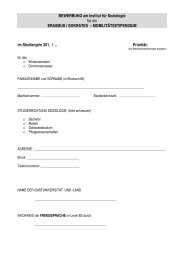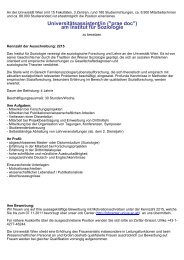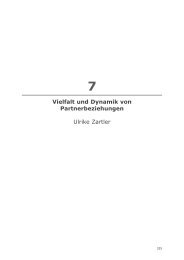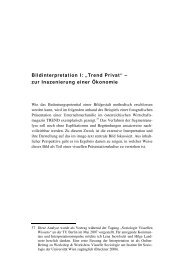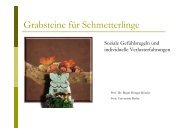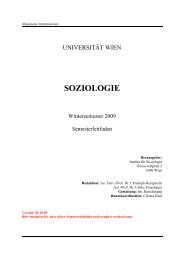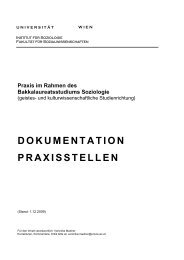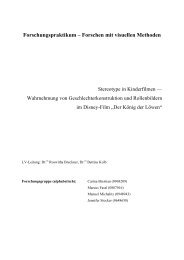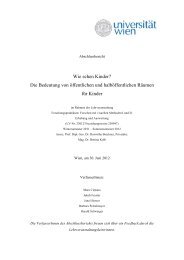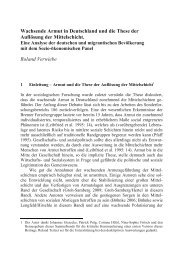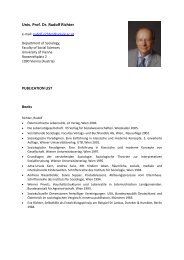Why do Europeans Migrate to Berlin? SocialStructural Differences ...
Why do Europeans Migrate to Berlin? SocialStructural Differences ...
Why do Europeans Migrate to Berlin? SocialStructural Differences ...
Create successful ePaper yourself
Turn your PDF publications into a flip-book with our unique Google optimized e-Paper software.
Edited by Elzbieta Gozdziak, George<strong>to</strong>wn University<br />
<strong>do</strong>i:10.1111/j.1468-2435.2010.00663.x<br />
MIGRATION<br />
<strong>Why</strong> <strong>do</strong> <strong>Europeans</strong> <strong>Migrate</strong> <strong>to</strong><br />
<strong>Berlin</strong>? Social-Structural<br />
<strong>Differences</strong> for Italian, British,<br />
French and Polish Nationals in the<br />
Period Between 1980 and 2002 *<br />
Roland Verwiebe**<br />
ABSTRACT<br />
One of the main issues in migration research concerns the reasons migrants<br />
have for crossing borders. It is assumed in the research that migration is<br />
primarily economically driven. In recent studies, however, the importance<br />
of social and cultural reasons for migration has become apparent. In this<br />
context, the present contribution discusses the reasons for the migration of<br />
<strong>Europeans</strong> from Italy, France, the United King<strong>do</strong>m, and Poland who<br />
moved <strong>to</strong> Germany (<strong>Berlin</strong>) between 1980 and 2002. In this case, it can be<br />
shown empirically that purely economic reasons play a lesser role in migration<br />
than is generally assumed, whereas social and cultural motives actually<br />
have a much greater influence. Primary data gathered in <strong>Berlin</strong> early<br />
in 2002 form the empirical foundation of the study. Multinomial logistic<br />
regressions are used <strong>to</strong> discuss the function of social-structural differences<br />
(e.g., nationality, age, gender, education, social origin) in the formation of<br />
individual reasons for migration.<br />
* The author wishes <strong>to</strong> thank the reviewers and edi<strong>to</strong>rs of International Migration as well as<br />
Sonja Drobnicˇ, Patrick Präg and Johannes Giesecke for their useful comments, which<br />
helped improve the manuscript. Gregory Sims helped improve the style of the article. The<br />
analyses carried out are based on a project which was funded by a research grant from the<br />
German Research Foundation. The project was organized by Klaus Eder and Roland<br />
Verwiebe.<br />
** Institute of Sociology, University of Vienna, Vienna.<br />
Ó 2011 The Author<br />
Published by Blackwell Publishing Ltd., International Migration Ó 2011 IOM<br />
9600 Garsing<strong>to</strong>n Road, Oxford OX4 2DQ, UK, International Migration<br />
and 350 Main Street, Malden, MA 02148, USA. ISSN 0020-7985
2 Verwiebe<br />
INTRODUCTION<br />
Migration processes are the result of complex decision making procedures.<br />
Usually, research in<strong>to</strong> migration places the effects of economic,<br />
social and ⁄ or cultural fac<strong>to</strong>rs at the centre of explana<strong>to</strong>ry models.<br />
Although most models include a number of different fac<strong>to</strong>rs, the literature<br />
is <strong>do</strong>minated by economic explanations of individual reasons for<br />
migration. In these explanations it is usually assumed that migrants follow<br />
the principle of economic rationalism, meaning that they strive <strong>to</strong><br />
improve their living and working conditions through migration (Castles,<br />
1986; Stark and Bloom, 1985). However, economic fac<strong>to</strong>rs <strong>do</strong> not operate<br />
in the abstract. Social networks, institutional channels and knowledge<br />
about language and culture are required <strong>to</strong> make migration a<br />
viable option for individual ac<strong>to</strong>rs. Against this background, the present<br />
article examines the motives for migration of French, Italian, British<br />
and Polish citizens who moved <strong>to</strong> <strong>Berlin</strong> ⁄ Germany between early 1980<br />
and January 2002, using this as a case of contemporary intra-European<br />
migration.<br />
The analyses of the present article are framed by the assumption that<br />
the European Union represents a specific migration space shaped by its<br />
own institutional and legal regulations (Baganha and Entzinger, 2004;<br />
Ette and Faist, 2007; Favell, 2003; King, 2002; Recchi, 2005; Scott,<br />
2006). In the European Union, national borders no longer function as<br />
the barriers that they once constituted, and moving between countries is<br />
simplified by the relative geographical proximity of the European<br />
nations. At the same time, new boundaries against outsiders (e.g., non-<br />
EU citizens, refugees from civil war areas) are being erected as an inherent<br />
element of the European integration process (Bach, 2005; Eder,<br />
2006). It is also typical of this specific European migration space that<br />
the process of European integration has modified the selection of migration<br />
populations over time. Between 1945 and the early 1970s, all the<br />
industrial economies of Western Europe had imported labour, especially<br />
for lower-skilled jobs (Castles, 2006: 742). The beginning of the twentieth<br />
century has seen an increase in the mobility of pre<strong>do</strong>minantly service-industry<br />
workers (both women and men) with diverse (and also<br />
often high) qualifications and from different European regions (European<br />
Commission, 2006: 224; King, 2002: 95; Verwiebe and Eder, 2006:<br />
143).<br />
Ó 2011 The Author<br />
International Migration Ó 2011 IOM
European migration <strong>to</strong> <strong>Berlin</strong> 3<br />
The empirical foundation of the present article is constituted by primary<br />
data gathered at the beginning of 2002, from a <strong>Berlin</strong>-based study of the<br />
conditions and effects of intra-European migration. Statistically, the<br />
article is based on multinomial logistic regressions (Greene, 2000), in<br />
which the effects of independent variables like nationality, age, gender,<br />
education, or social origin on individual reasons for migration will be<br />
analysed. Thus, social-structural differences in the formation of reasons<br />
for migration will be studied empirically.<br />
THEORETICAL BACKGROUND: REASONS FOR MIGRATION<br />
Reasons for migration have been given extensive attention by researchers,<br />
with contributions <strong>to</strong> the field coming mostly from economists, sociologists<br />
and geographers. On a theoretical level, the research on<br />
individual reasons for migration has been <strong>do</strong>minated for quite some<br />
time by economic explanations – explanations which, interestingly, have<br />
been proposed not only by economists but also by sociologists (e.g.,<br />
Castles, 2006; Ghatak et al., 1996; Kalter, 2000; Lee, 1966; Rist, 1978;<br />
Salt, 1993; Stark, 1991; Zimmermann, 2005). As Halfacree, in his critical<br />
study of non-economically-based migration decisionmaking, states: ‘‘In<br />
the majority of studies on migration – whether from a neo-classical or a<br />
Marxian perspective – it has been (and still is) the economic aspect that<br />
has been emphasized most strongly’’ (Halfacree, 2004: 242). What is the<br />
core argument in economically-based migration studies? Regardless of<br />
whether one chooses a macroeconomic or a microeconomic perspective,<br />
it is common sense that migrants follow the principles of economic<br />
rationalism, acting in response <strong>to</strong> push-and-pull fac<strong>to</strong>rs. Central pushand-pull<br />
fac<strong>to</strong>rs concern the situation in the employment market and<br />
attainable individual income, respectively, which are, in theory, inadequate<br />
in the migrants’ country of origin, and considerably more attractive<br />
in the destination country (Berninghaus and Seifert-Vogt, 2002;<br />
Fielding, 1993; Stark and Bloom, 1985; Todaro, 1986). This model usually<br />
refers <strong>to</strong> economic gains from migration conceptualised as differences<br />
in wages, differences in working conditions or available fringe<br />
benefits. Based on such a model, it could be argued that individuals<br />
from nations with lower labour productivity and lower wages would be<br />
strongly motivated <strong>to</strong> move <strong>to</strong> nations with higher labour productivity<br />
and wages. The intra-European migration his<strong>to</strong>ry of the Italians for<br />
example, with their strong economic reasons for migration, resembles<br />
this model <strong>to</strong> some extent.<br />
Ó 2011 The Author<br />
International Migration Ó 2011 IOM
4 Verwiebe<br />
Through the influence of migration researchers like De Jong and<br />
Fawcett (1981), Kalter (1997) or Esser (2004) and their ideas on the<br />
‘‘subjective expected utility’’ of migration, it has become established<br />
practice <strong>to</strong> assume that objective, economic imbalances in the labour<br />
market will be reflected differently from one individual <strong>to</strong> another –<br />
which makes social-structural differences in the formation of reasons for<br />
migration a central point of interest (Plane, 1993). One might expect <strong>to</strong><br />
find substantial differences in the reasons for migration relating <strong>to</strong> gender,<br />
age, education, time of migration and social origin, which opens up<br />
a number of areas for research. In classical economic explanations, for<br />
example, the main migration ac<strong>to</strong>rs are men who are seeking employment<br />
abroad (e.g., Lee, 1966: 50), whereas women tend <strong>to</strong> accompany<br />
their migrating husbands and ⁄ or fathers. If one applies these assumptions<br />
<strong>to</strong> the migration of European women <strong>to</strong> <strong>Berlin</strong>, it could well be<br />
that women’s reasons for migrating are driven less by career interests or<br />
the search for a job which remains <strong>to</strong> be examined empirically, if one<br />
considers more recent studies on the migration patterns of women (compare<br />
for example, Curran et al., 2006; González-Ferrer, 2006; Kofman<br />
et al., 2000; Mahler and Pessar, 2006; Pedraza, 1991; Raghuran, 2008).<br />
With regard <strong>to</strong> the influence of education on the formation of reasons<br />
for migrating, it might be assumed that less qualified as well as highly<br />
qualified <strong>Europeans</strong> (classical labour, elite migration) have particularly<br />
pronounced economic motives for migration (Beavers<strong>to</strong>ck, 2005; Castles,<br />
1986; Findlay et al., 1996; Johnson, 1980; Peixo<strong>to</strong>, 2001; Salt, 1993). In<br />
that context, some authors argue that the migration of highly qualified<br />
people has <strong>to</strong> been seen increasingly against the background of European<br />
integration. Favell (2008) for example, has focused in his recent<br />
work on highly skilled European migrants (mainly in services, IT, banking<br />
and media) in ‘‘Eurocities’’ such as Brussels, Amsterdam, Paris and<br />
Lon<strong>do</strong>n, which benefit from specific European structures of opportunity.<br />
King argues in a similar way: ‘‘The movement of skilled persons lies at<br />
the heart of the attempts <strong>to</strong> integrate Europe through the free movement<br />
of people, goods, services and capital within the EU’’ (King, 2002: 98).<br />
An important complement <strong>to</strong> economic approaches is provided by concepts<br />
that underscore the significance of social fac<strong>to</strong>rs – above all, the<br />
function of social networks and the importance of family-related migration<br />
– in the formation of reasons for migration (Braun and Recchi,<br />
2008; Haug, 2005; Johns<strong>to</strong>n et al., 2006; Palloni et al., 2001; Pries,<br />
2001). These studies have had an impact on the way reasons for migration<br />
have been re-theorised over the last decade. For Pries (2001), for<br />
example, it is not economic fac<strong>to</strong>rs such as wage differences that are<br />
Ó 2011 The Author<br />
International Migration Ó 2011 IOM
European migration <strong>to</strong> <strong>Berlin</strong> 5<br />
decisive, but rather ‘‘the quality of the networks linking the regions of<br />
origin and destination, as well as social relationships based on trust and<br />
longer-term calculability’’ (Pries, 2001: 34). Accordingly, one can concur<br />
that personal relationships and information channels between those who<br />
have already migrated and those who are latently contemplating migration<br />
can play a decisive role in the decision <strong>to</strong> migrate. In other words,<br />
economic fac<strong>to</strong>rs <strong>do</strong> not operate in the abstract; social channels and networks<br />
are required <strong>to</strong> make migration a viable option. The spectrum of<br />
these social fac<strong>to</strong>rs can cover, for example, support in finding a job or<br />
information on the housing market, as well as the usage of existing ties<br />
or the formation of new social bonds through migration for marriage or<br />
family-related migration. In his critically-acclaimed book, Faist (2000)<br />
emphasizes, for example the high relevance of social networks for migration<br />
processes. Based on a elaborated action theory, he argues that<br />
‘‘social relations, viz. ties in collectives and networks, constitute distinct<br />
sets of intermediate structures on the meso level. It is via these relations<br />
that ac<strong>to</strong>rs relate their resources <strong>to</strong> opportunity structures’’ (Faist, 2000:<br />
100). And he concludes that, in the case of international migration, new<br />
(and also old) ties and corresponding capital often crystallize in migrant<br />
networks. The uneven distribution of resources mobilized through these<br />
social networks helps <strong>to</strong> account for different rates of migration out of<br />
various regions and differences within migration communities (Faist,<br />
2000: 123).<br />
Turning more specifically <strong>to</strong> marriage and family-related migration, it is<br />
crucial for migration studies <strong>to</strong> deal with these fac<strong>to</strong>rs, since, according<br />
<strong>to</strong> Kofman (2004), their relevance for intra-European migration and<br />
migration <strong>to</strong> Europe can no longer be overlooked. Kofman (2004)<br />
claims that, despite the significance of family migration, there has been<br />
little general analysis of the many relevant issues associated with it. 1<br />
European research, in particular, has neglected many key aspects of<br />
family and marriage migration, which is due <strong>to</strong> the ‘‘primacy of labour<br />
migration in European countries’’ (Kofman, 2004: 244). 2 Braun and<br />
Recchi (2008: 165ff.) also attach great importance <strong>to</strong> migration for marriage<br />
or family-related migration, since their study suggests that these<br />
social fac<strong>to</strong>rs are quite significant for recent migration movements<br />
within the European Union. Empirically, these forms of migration are<br />
more likely <strong>to</strong> affect women than men (Halfacree, 1995), and are more<br />
common in younger groups who are of an age <strong>to</strong> marry. ‘‘Family migrations<br />
are gendered […] Women entering [a country] through familyrelated<br />
migrations are not just the followers of the male primary<br />
Ó 2011 The Author<br />
International Migration Ó 2011 IOM
6 Verwiebe<br />
migrant’’, writes Kofman (2004: 256) in her comprehensive review article<br />
on the facets of family-related migration in Europe.<br />
Recently, some authors have pointed <strong>to</strong> the relevance of cultural motives<br />
and institutional programmes 3 for migration (Blotevogel et al., 1993;<br />
Castles, 2004; Castles and Miller, 2003; Entzinger, 2000; Findlay et al.,<br />
2006; Halfacree, 2004; Hazen and Alberts, 2006; Recchi, 2005). These<br />
types of motive are <strong>to</strong> be found especially among highly skilled individuals,<br />
among younger age groups, and student populations. The phenomenon<br />
of student migration, for example, is described by Findlay et al.<br />
(2006) in the following manner: ‘‘Given its link with … European integration,<br />
it is not surprising that international student migration has<br />
increased rapidly in most parts of Europe’’ (ibid.: 291f.). With regard <strong>to</strong><br />
cultural ⁄ lifestyle-based reasons for migration, the work of Scott is useful<br />
(2006: 1114). Beyond crucial economic and professional fac<strong>to</strong>rs, Scott’s<br />
results on British migration <strong>to</strong> Paris highlight ‘‘the significance of<br />
cultural preferences’’ (fac<strong>to</strong>rs such as interest in, and accessibility of, a<br />
language, his<strong>to</strong>rical interests or the culture of a city) for contemporary<br />
forms of intra-European migration, which demonstrates, as he puts it,<br />
‘‘the need <strong>to</strong> bring the cultural agency of world cities in<strong>to</strong> the mobility<br />
equation’’ (2006: 1114). A number of recent studies contributing <strong>to</strong> the<br />
field suggest that cultural-institutional reasons for migration have<br />
become increasingly common since the implementation of the Maastricht<br />
Treaty, which not only led <strong>to</strong> the creation of the Euro and a common<br />
foreign and security policy but also <strong>to</strong> a reduction of the barriers<br />
<strong>to</strong> intra-European labour market mobility and mobility based on institutional<br />
European programmes (e.g., Braun and Recchi, 2008; Ette and<br />
Faist, 2007; European Commission, 2002; Favell, 2003; Recchi, 2005).<br />
Thus, the Maastricht Treaty gave EU citizens a legal entitlement <strong>to</strong> free<strong>do</strong>m<br />
of movement and settlement, mutual recognition of their educational<br />
qualifications and created the formal legal conditions for<br />
unhindered mobility for EU citizens and for a (western) European<br />
labour market. With European citizenship, introduced as part of the<br />
Maastricht Treaty, European citizens were granted a status which is fundamentally<br />
different <strong>to</strong> that of non-EU citizens. Based on the free<strong>do</strong>m<br />
of movement, the legal status of EU citizens includes wide-ranging entitlements<br />
<strong>to</strong> equal treatment in the country of residence. Along with the<br />
legal conditions for, effectively, barrier-free migration, the European<br />
Union also introduced measures designed <strong>to</strong> boost mobility, including<br />
exchange programmes such as Erasmus or Socrates, and created special<br />
institutions such as the European Employment Services (EURES) which<br />
promote employee mobility.<br />
Ó 2011 The Author<br />
International Migration Ó 2011 IOM
European migration <strong>to</strong> <strong>Berlin</strong> 7<br />
As mentioned, research in<strong>to</strong> migration traditionally places the effects of<br />
economic, social and cultural fac<strong>to</strong>rs at the centre of explana<strong>to</strong>ry models.<br />
However, starting in the 1980s, researchers have argued increasingly<br />
that focusing on single reasons is no longer sufficient <strong>to</strong> explain the formation<br />
of reasons for migration since they are the result of complex<br />
decision-making procedures. Thus, migration is not based solely on economics<br />
or exclusively on integration in<strong>to</strong> social networks, but instead<br />
has its origin in a complex set of motives. It seems that it wasn’t until<br />
the 1990s that it became possible <strong>to</strong> bring this undervalued aspect of the<br />
migration process <strong>to</strong> centre-stage of the research (Halfacree, 2004: 241).<br />
It is important for the newer generation of studies <strong>to</strong> recognise the<br />
‘‘multiple currents that feed in<strong>to</strong> the decision-making process’’. As<br />
Halfacree (2004: 241) puts it, migrants are ‘‘likely <strong>to</strong> provide multiple<br />
reasons, even if entangled and often partial, for their action’’. Following<br />
the work of Portes and Rumbaut (2001), for example, in contemporary<br />
research it is usually argued that a whole set of reasons will typically<br />
come in<strong>to</strong> play in an individual decision <strong>to</strong> migrate (e.g., Fourage and<br />
Ester, 2007; Halfacree, 2004; Hazen and Alberts, 2006; Lundholm,<br />
2007): the income and labour market situation, network position, family<br />
constellation, the usability of qualifications in the country of destination,<br />
language skills, or institutional regulations concerning migration. However,<br />
the available data will show whether the formation of reasons for<br />
migration can be explained mainly through economic, social (e.g., based<br />
on social networks) or cultural reasons (e.g., based on the Erasmus programme),<br />
or whether a complex set of motives lies behind the decision<br />
<strong>to</strong> migrate. This is the question <strong>to</strong> be studied here, taking in<strong>to</strong> account<br />
individual differences in the formation of migration reasons, based on<br />
social status variables.<br />
BERLIN AS A CASE FOR INTRA-EUROPEAN MIGRATION<br />
With 3.4 million inhabitants, <strong>Berlin</strong> is the second-largest city in the European<br />
Union, after Lon<strong>do</strong>n. <strong>Berlin</strong> was selected in order <strong>to</strong> study the facets<br />
of contemporary intra-European migration because, more than other<br />
major German cities, it experienced a growing number of intra-European<br />
migrants in the 1990s: in 1992 circa 78,000 Polish and EU-15 nationals<br />
lived in <strong>Berlin</strong>; in 2001 this number had reached 96,000, rising <strong>to</strong> 125,000<br />
by 2008 (Amt fu¨ r Statistik <strong>Berlin</strong>-Brandenburg, 2008). Polish and EU-15<br />
migrants now represent between a quarter and a third of the <strong>to</strong>tal foreign<br />
population in <strong>Berlin</strong>, which s<strong>to</strong>od at 473,000 in 2008 (Amt fu¨ r Statistik<br />
<strong>Berlin</strong>-Brandenburg, 2008). 4 These changes in the composition of the<br />
Ó 2011 The Author<br />
International Migration Ó 2011 IOM
8 Verwiebe<br />
population are rooted in the recent his<strong>to</strong>ry of the city. During the 1990s,<br />
de-industrialization, growth of the service sec<strong>to</strong>r and population decline<br />
led <strong>to</strong> a surplus of cheap housing in inner-city areas (Kra¨ tke, 2004). The<br />
inward migration of European nationals and West Germans were corresponding<br />
processes. Thus, the city symbolises the overcoming of divided,<br />
post-war Europe and the rapid societal changes in Germany and Europe<br />
since 1989. As Scott (2007: 8) states, <strong>Berlin</strong> is now well integrated in<strong>to</strong><br />
the global economic system and whilst it ‘‘… may not stand out in terms<br />
of its position within the global urban hierarchy, … [<strong>Berlin</strong>’s] progress<br />
since 1989 has been extremely significant’’.<br />
In terms of labour market structures, the economic activity rate is relatively<br />
high. It s<strong>to</strong>od at circa 70 per cent for women and 80 per cent for<br />
men in 2006. With more than 80 per cent of the jobs, the service sec<strong>to</strong>rs<br />
(media, research, government, education, consulting, advertising, commerce)<br />
are much more important than construction and manufacturing<br />
(SÖSTRA, 2007: 117), in which approximately 250,000 jobs were lost<br />
between 1991 and 2005 (SO¨ STRA, 2007: 12). Thus, traditional German<br />
industries ‘‘like textile or metal processing, as well as technology-centred<br />
industries like vehicle manufacturing or mechanical engineering, are far<br />
less represented in <strong>Berlin</strong> than in the other urban economic centres of<br />
Germany’’ (Krätke, 2004: 512). <strong>Berlin</strong> is host <strong>to</strong> fewer company headquarters<br />
than other major cities of its size. However, several companies<br />
(e.g., Deutsche Bahn, Sony Europe, Air <strong>Berlin</strong>, KPMG, Bayer Schering)<br />
have relocated their headquarters <strong>to</strong> <strong>Berlin</strong>, due <strong>to</strong> the modest economic<br />
recovery of recent years. 5 In the context of the late, but massive tertiary<br />
restructuring of <strong>Berlin</strong>, Kra¨ tke (2004) has argued for the development of<br />
a ‘‘creative class’’ in <strong>Berlin</strong>, the ‘‘city of talents’’, based around the<br />
media industry, software production, advertising and research.<br />
It can be assumed that this local context has consequences for the social<br />
composition of migrant populations and the shaping of migrant biographies.<br />
In the 1960s and 1970s (West) <strong>Berlin</strong> was a major destination for<br />
classical intra-European labour migrants, who were seeking employment<br />
in manufacturing. This changed <strong>to</strong> some degree throughout the 1980s<br />
when – unlike other cities in Germany – cultural ⁄ lifestyle-based migration<br />
became more important. For more recent migration processes, there<br />
is a tendency, in comparison <strong>to</strong> the period of pre<strong>do</strong>minantly lower-class<br />
labour migration of the 1960s and 1970s, <strong>to</strong>wards an increasing portion<br />
of migrants belonging <strong>to</strong> an ‘‘emergent migrant middle class’’ (Verwiebe,<br />
2008) or <strong>to</strong> the growing ‘‘creative class’’ of <strong>Berlin</strong> (Kra¨ tke, 2004: 512).<br />
However, it seems mostly an empirical question what reasons for migra-<br />
Ó 2011 The Author<br />
International Migration Ó 2011 IOM
European migration <strong>to</strong> <strong>Berlin</strong> 9<br />
tion <strong>to</strong> <strong>Berlin</strong> are typical as a specific case of intra-European migration<br />
in the 1990s and at the beginning of the 21st century – a question <strong>to</strong><br />
which, it is hoped, the present study can provide some answers.<br />
For the empirical study of the present contribution, European nationals<br />
who moved <strong>to</strong> <strong>Berlin</strong> between 1980 and 2002 were selected. They are from<br />
countries that allow one <strong>to</strong> take in<strong>to</strong> account the varying traditions of<br />
migration and the degree of institutional and cultural integration in the<br />
EU (Bade, 1987; Blotevogel et al., 1993; Castles, 2006; Fassmann and<br />
Mu¨ nz, 1994). More than the other national groups, Italy exemplifies the<br />
tradition of classical intra-European labour migration and, despite a<br />
return migration in recent years, Italians still constitute one of the largest<br />
migrant communities in Germany (15,000 living in <strong>Berlin</strong> in 2008). One<br />
could expect economic reasons for migration <strong>to</strong> pre<strong>do</strong>minate in this<br />
group because these were the <strong>do</strong>minant motives for classical Italian<br />
labour migration (Bender and Seifert, 1998; Blotevogel et al., 1993; Del<br />
Boca and Venturini, 2003). As an accession country, Poland represents a<br />
specifically Eastern European tradition of linkage <strong>to</strong> the German labour<br />
market and is regarded as a specific ‘‘reference case’’. The reasons for<br />
migration of Polish migrants, in particular, should differ from those of<br />
other <strong>Europeans</strong>, primarily because, at the time the data was collected,<br />
Poland was not yet a member of the EU (it is now a full member). Thus,<br />
amongst this group, one could expect <strong>to</strong> find more social reasons for<br />
migration, such as migration for marriage and migration based on network<br />
relations (Haug, 2005). With 45,000 people (Amt fu¨ r Statistik<br />
<strong>Berlin</strong>-Brandenburg, 2008: 15), the Polish community is one of the largest<br />
migration communities in <strong>Berlin</strong>. France and Great Britain each represent<br />
independent migration models and modes of integration in<strong>to</strong> the European<br />
Union. A relatively new phenomenon, the intra-European migration<br />
of French and British citizens increased noticeably in the 1990s. In 2008<br />
almost 13,000 French citizens and circa 10,000 British citizens were living<br />
in <strong>Berlin</strong> (Amt fu¨ r Statistik <strong>Berlin</strong>-Brandenburg, 2008: 15), whereas in<br />
1995 the numbers s<strong>to</strong>od at 7,500 (French) and 8,000 (British). For these<br />
countries, active student exchanges (which would increase the likelihood<br />
of cultural ⁄ institutional motives for migration) and the stationing of military<br />
forces in Germany also play important roles.<br />
DATA AND METHODS<br />
The quantitative data come from the <strong>Berlin</strong> Study of Transnational<br />
Mobility in Europe (BSTME) project, in which intra-European migration<br />
Ó 2011 The Author<br />
International Migration Ó 2011 IOM
10 Verwiebe<br />
was studied against the background of the European integration process.<br />
Funded by a research grant from the German Research Foundation, the<br />
BSTME-project was carried out in <strong>Berlin</strong> using a qualitative study and a<br />
quantitative survey. 6<br />
Data<br />
For the quantitative analysis, a data set of 1,040 European citizens<br />
[from Italy (n = 210), France (n = 302), Great Britain (n = 270), and<br />
Poland (n = 258)] was used. This data set is based on a standardised,<br />
postal survey of 2,043 European nationals plus a German control group,<br />
who were ran<strong>do</strong>mly selected from the records of the <strong>Berlin</strong> state census<br />
bureau and who were representative with regard <strong>to</strong> age and gender for<br />
the examined groups. Nine out of ten of those interviewed moved <strong>to</strong><br />
<strong>Berlin</strong> directly from another European country, a smaller portion had<br />
spent some time in another German city before coming <strong>to</strong> <strong>Berlin</strong>. From<br />
this survey (n = 2,043), migrants were selected who moved <strong>to</strong> <strong>Berlin</strong><br />
between January 1980 and January 2002 (n = 1,040). Additionally, they<br />
had <strong>to</strong> be registered at the State Census Bureau, which is obliga<strong>to</strong>ry for<br />
all individuals in Germany. Due <strong>to</strong> the fact that a ran<strong>do</strong>mly-selected,<br />
representative sample from the records of the <strong>Berlin</strong> state census uses<br />
only registered EU-migrants, neither return migrants nor illegal migrants<br />
are contained in the sample. Both phenomena are, however, quite extensively<br />
examined in the research. 7<br />
The BSTME-project used clear and well-established metho<strong>do</strong>logical<br />
principles in order <strong>to</strong> guarantee high-quality data. To that end,<br />
Dillman’s Total Design Method (2002) was used for the mail survey, the<br />
questions in the questionnaire were <strong>to</strong> a large extent based on tested<br />
scales available from the ZUMA-Handbook of Scales (see http://<br />
www.gesis.org/en/services/methods/services/zisehes/), a questionnaire in<br />
German and in the native language of the respondents was sent out, the<br />
questionnaires were translated by professional transla<strong>to</strong>rs, and the main<br />
survey was preceded by a pre-test using approximately 4 per cent of the<br />
<strong>to</strong>tal 2,043 cases studied in the main survey. The main survey was carried<br />
out within a relatively short period, between January and March of<br />
2002, with a return rate of approximately 20 per cent.<br />
This response rate needed <strong>to</strong> be examined with regard <strong>to</strong> the data quality.<br />
A first look at the literature showed that the response lies within the<br />
usual spectrum of response rates (between 5 and 50%) in the research<br />
(Dillman, 2000). 8 In a second step, the demographic composition of the<br />
Ó 2011 The Author<br />
International Migration Ó 2011 IOM
sample (age, gender) was controlled for with regard <strong>to</strong> the base population<br />
of the study: The sample has 53 per cent females and 47 per cent<br />
males, all aged between 21 and 65, ages at which people typically engage<br />
in employment. Women are slightly over-represented, especially in the<br />
Polish sample. The age structure of the groups surveyed matches the age<br />
structure in the state census records. A further examination of the data<br />
quality (e.g., regarding education or industry affiliation) was not possible,<br />
as none of the usual comparison methods (census data, GSOEP<br />
data) is available for the nationalities investigated. Some European<br />
nationals are integrated in the 1-per-cent-household sample of the<br />
German microcensus data or in the GSOEP. Due <strong>to</strong> very small case<br />
numbers and strong dis<strong>to</strong>rtions during the data collection, meaningful<br />
comparisons with these data sources are not possible for the national<br />
groups being analysed in this study.<br />
Dependent Variable<br />
European migration <strong>to</strong> <strong>Berlin</strong> 11<br />
In the questionnaire, respondents were asked about their reasons for<br />
migration with an open-ended question, which is a widely-used procedure<br />
in migration research (Nie<strong>do</strong>mysl and Malmberg, 2009: 80ff.).<br />
From the results, we were able <strong>to</strong> extract 21 different categories on the<br />
basis of exact coder instructions. 9 In order <strong>to</strong> analyse this diversity of<br />
reasons with regard <strong>to</strong> differing social status, it was necessary <strong>to</strong> summarise<br />
these categories. For the analyses of the present paper, from the<br />
more than 20 different reasons for migrating within Europe, three main<br />
categories were formed: (1) economic and occupational reasons (in the<br />
following referred <strong>to</strong> as solely economic reasons), (2) solely social reasons<br />
(e.g., network-related and personal reasons based on family relations,<br />
partnerships and friendships), and (3) cultural and institutional<br />
reasons (in the following referred <strong>to</strong> as solely cultural reasons), such as<br />
interest in another language and culture, interests in the city of <strong>Berlin</strong>,<br />
and institutional migration based on EU programmes like Erasmus. 10<br />
There is also a fourth category in which ‘‘mixed’’ reasons for migration<br />
are summarised (please refer <strong>to</strong> the appendix for the operationalisation<br />
of the dependent variable).<br />
Multinomial Logistic Regression<br />
The empirical analysis starts with the main descriptive results. 11 These<br />
are followed by a multinomial logistic regression, which makes it possible<br />
<strong>to</strong> test the influence of independent variables on a nominal dependent<br />
variable (1, 2, ... m). Presenting the results of multinomial<br />
Ó 2011 The Author<br />
International Migration Ó 2011 IOM
12 Verwiebe<br />
regressions is always complex, due <strong>to</strong> the reference categories both in<br />
dependent and independent variables. The dependent variable reasons<br />
for migration has four categories. Multinomial logistic regression calculates<br />
for each category of y the corresponding regression coefficients<br />
b (1) , b (2) , b (3) , b (4) . Thus, mathematically, the multinomial logistic<br />
regression can be defined in the following manner (Greene 2000: 859):<br />
P(y ¼ 1Þ ¼e Xbð1Þ =ðe Xbð1Þ þ e Xbð2Þ þ e Xbð3Þ þ 1Þ<br />
P(y ¼ 2Þ ¼e Xbð2Þ =ðe Xbð1Þ þ e Xbð2Þ þ e Xbð3Þ þ 1Þ<br />
P(y ¼ 3Þ ¼e Xbð3Þ =ðe Xbð1Þ þ e Xbð2Þ þ e Xbð3Þ þ 1Þ<br />
P(y ¼ 4Þ ¼1=ðe Xbð1Þ þ e Xbð2Þ þ e Xbð3Þ þ 1Þ<br />
The coefficients b (1) (solely social reasons), b (2) (solely economic reasons),<br />
b (3) (solely cultural reasons), measure the relative differences<br />
against the reference category y = 4 (mixed reasons). This reference category<br />
was chosen for content-related reasons: the theoretical debate is<br />
mainly organised around a discussion of the relevance of economic and<br />
social reasons, but recently cultural reasons have also been given some<br />
attention. Mathematically, a different reference category for the dependent<br />
variable <strong>do</strong>es not change the results of the model. The exponential<br />
value (odds ratio) of the parameters b can be used for the interpretation<br />
of the results. They refer <strong>to</strong> the risk ⁄ chance of an event occurring. These<br />
odds ratios always take values > 0. A positive effect of the odds ratios<br />
is expressed as e b >1, a negative effect as e b
European migration <strong>to</strong> <strong>Berlin</strong> 13<br />
variable time of migration was included in the analysis in order <strong>to</strong> find<br />
out whether migration that <strong>to</strong>ok place before and after the implementation<br />
of the Maastricht Treaty is differentiated, using 1 January 1994 for<br />
practical reasons (also the date of the second stage of the Economic and<br />
Monetary Union of the EU) as the distinguishing boundary. The dicho<strong>to</strong>mous<br />
variable network uses the information on the characteristics of<br />
the respondents’ social network (member of pre<strong>do</strong>minantly national ⁄<br />
ethnic network = 1). It measures the current level of integration in networks<br />
which in most cases were in place prior <strong>to</strong> the migration. For the<br />
dicho<strong>to</strong>mous variable social origin a collapsed five-ladder Erikson-Goldthorpe<br />
class scheme (Erikson and Goldthorpe, 1992b) was the basis,<br />
using information on the current occupation or, if retired, the last occupation<br />
of the fathers and ⁄ or mothers of the respondents (father and ⁄ or<br />
mother member of EGP service class = 1). Thus, with this list of variables,<br />
and although this is a comparatively modest study, we were able<br />
<strong>to</strong> analyse the reasons for intra-European migration in a quite diverse<br />
manner. Nevertheless, due <strong>to</strong> the data limitations, further, preferable differentiations<br />
were not possible. In the last model, the interaction effects<br />
of these variables with national origin were included. In this way,<br />
‘‘national’’ samples can be compared with one another, and one can<br />
investigate the extent <strong>to</strong> which reasons for migration vary according <strong>to</strong><br />
the land of origin and ⁄ or <strong>to</strong> social status (see the tables of the appendix<br />
for the operationalisation and description of the variables).<br />
FINDINGS<br />
The following discussion of the findings is based on the idea that intra-<br />
European migration is a special form of migration and that this is also<br />
reflected in the individual reasons for migration. From an empirical perspective,<br />
European citizens have quite heterogeneous reasons for migrating.<br />
Figure 1 shows the main reasons of intra-European migrants who<br />
moved <strong>to</strong> <strong>Berlin</strong> between the beginning of 1980 and January 2002.<br />
Somewhat less than a third of the participants (30%) give social reasons<br />
as the sole reason for their intra-European migration, while economic<br />
reasons are ranked third (14%). Solely cultural and institutional reasons<br />
are mentioned by 19 per cent of the participants. A set of ‘‘mixed’’ reasons<br />
from the three categories are mentioned by 37 per cent of the<br />
respondents.<br />
Surprisingly, these results <strong>do</strong> not support the main assumptions in the<br />
research regarding the <strong>do</strong>minance of economic fac<strong>to</strong>rs among the<br />
Ó 2011 The Author<br />
International Migration Ó 2011 IOM
14 Verwiebe<br />
Social and cultural<br />
reasons<br />
11%<br />
Economic and<br />
cultural reasons<br />
10%<br />
Economic and social<br />
reasons<br />
11%<br />
Cultural reasons<br />
19%<br />
FIGURE 1<br />
REASONS FOR MIGRATION TO BERLIN (1980–2002)<br />
Source: BSTME 2002, n = 1040, our own calculation.<br />
Social, cultural,<br />
economic reasons<br />
5%<br />
Social reasons<br />
30%<br />
Economic reasons<br />
14%<br />
reasons for migration. It is evident that economic reasons are not paramount<br />
for European nationals who migrated <strong>to</strong> <strong>Berlin</strong> between 1980<br />
and 2002. For 26 per cent of the individuals, economic reasons play a<br />
role in the decision <strong>to</strong> migrate, since the decision is based on a broad set<br />
of motives, including economic motives. However, only one in seven of<br />
the respondents mentioned economic reasons as the only or paramount<br />
fac<strong>to</strong>r. A noticeably higher importance is assigned <strong>to</strong> family and marriage-related<br />
and personal reasons, or <strong>to</strong> the respondent’s network,<br />
which, according <strong>to</strong> the data used here, constitute the most important<br />
reasons for migration within Europe (compare Braun and Recchi, 2008;<br />
Kofman, 2004). Lundholm (2007: 32), for example, also concludes that<br />
‘‘the most frequent motive for migrants … is social (40%)’’. King (2002:<br />
99) attaches great importance <strong>to</strong> the social fac<strong>to</strong>r in migration as well,<br />
which he beliefs is especially important for migration <strong>to</strong> major European<br />
cities. Furthermore, the cultural aspect plays an important role in intra-<br />
European migration, as in Scott’s (2006) study on Paris, regardless of<br />
whether it is based on an interest in a different language and culture or<br />
upon institutional migration established in order <strong>to</strong> enhance European<br />
integration (Castles, 2004; Findlay et al., 2006; King and Ruiz-Gelices,<br />
2003; Lundholm, 2007). This result indicates, as assumed earlier in the<br />
Ó 2011 The Author<br />
International Migration Ó 2011 IOM
European migration <strong>to</strong> <strong>Berlin</strong> 15<br />
paper, that when <strong>Berlin</strong> is selected as a migration destination, cultural<br />
⁄ lifestyle-based migration is quite important.<br />
These general trends are likely <strong>to</strong> vary with respect <strong>to</strong> national origin<br />
and social status variables. This will be tested below using three different<br />
multinomial logistic regression analyses (Greene, 2000). The results of<br />
multinomial regressions are not easy <strong>to</strong> read because there is a reference<br />
category for the dependent variable (unlike, for example, in linear<br />
regression) as well as reference categories for the independent variables<br />
(as in other regression methods). For example, mathematically, the findings<br />
in the first model show that Italian, French and British respondents<br />
are less likely <strong>to</strong> give solely social reasons for migration compared <strong>to</strong><br />
the reference category of mixed reasons than the Polish respondents<br />
(which is the reference group). In order <strong>to</strong> make it easier <strong>to</strong> read the<br />
findings, odds ratios (which refer <strong>to</strong> relative risks ⁄ chances of an event<br />
occurring) will be presented as trend results.<br />
Turning now <strong>to</strong> the results, according <strong>to</strong> the first model, there are evident<br />
differences between national groups. Solely social reasons for<br />
migration, that is, based on integration in<strong>to</strong> networks or on familyrelated<br />
⁄ personal motives, are mentioned significantly less often by the<br />
Italian, French and British migrants than by those from the Polish reference<br />
group. Results of another recent study also reveal that Polish<br />
migrants – as well as other groups migrating from Eastern Europe <strong>to</strong><br />
Germany (Kofman, 2004: 252) – have strong migration-related networks<br />
and are often married <strong>to</strong> German partners (Haug, 2005), which possibly<br />
influences the formation of reasons for migration. As expected on the<br />
basis of the literature (Bender and Seifert, 1998; Del Boca and Venturini,<br />
2003), Italians are more likely <strong>to</strong> migrate for solely economic reasons<br />
(+60%). The British migrants are approximately 50 per cent less likely<br />
<strong>to</strong> migrate for solely cultural reasons than the Polish reference group.<br />
The results of the second regression model are shown in the middle column<br />
of Table 1. They indicate that differences in national origin carry<br />
less weight in reasons for migrating than the social status of the respondents<br />
of this study on migration <strong>to</strong> <strong>Berlin</strong>: most of the significant effects<br />
of nationality disappear in the second model and the fit of the model<br />
increases markedly once social status variables are included.<br />
Moreover, the results reveal a number of interesting social-structural<br />
differences in the respondents’ reasons for migration. The regression<br />
analyses indicate, for example, a special role for the group aged between<br />
Ó 2011 The Author<br />
International Migration Ó 2011 IOM
TABLE 1<br />
16 Verwiebe<br />
MULTINOMIAL LOGISTIC REGRESSIONS FOR REASONS FOR MIGRATION TO BERLIN BETWEEN 1980 AND 2002<br />
(EXP(B)-COEFFICIENTS)<br />
Model 1 Model 2 Model 3<br />
Cultural<br />
reasons<br />
Economic<br />
reasons<br />
Social<br />
reasons<br />
Cultural<br />
reasons<br />
Economic<br />
reasons<br />
Social<br />
reasons<br />
Cultural<br />
reasons<br />
Economic<br />
reasons<br />
Social<br />
reasons<br />
Reference: Mixed<br />
reasons for migration<br />
Polish<br />
British 0.399*** 0.852 0.476*** 0.800 1.020 0.434** 1.536 0.807 0.873<br />
French 0.352*** 0.931 1.057 0.642* 1.384 0.896 1.184 0.675 0.746<br />
Italian 0.517*** 1.593* 0.762 0.859 1.179 0.635 1.658 1.297 0.476<br />
Migration age (21–29 years = 1) 0.638*** 0.566*** 1.509* 0.478** 0.370* 1.048<br />
Gender (women = 1) 2.452*** 0.544*** 1.089 4.240*** 0.500* 0.714<br />
Occupational training sc. level<br />
University ⁄ college degree 0.463*** 0.588 2.332*** 0.363** 0.504 3.524**<br />
No occupational training 0.479*** 1.035 1.913** 0.626* 0.841 2.074*<br />
Time of migration (after 1994 = 1) 1.342* 1.170 1.896*** 1.626* 0.682 1.073<br />
German ⁄ multicultural network<br />
National ⁄ ethnic network 1.882** 3.919*** 1.522 2.110* 3.721** 1.606<br />
Social origin (EGP-class 5 = 1) 0.565*** 0.764 1.458* 0.565* 0.723 2.329**<br />
Age*French 1.910*<br />
Age*Italian 1.473*<br />
Gender*British 0.313**<br />
Gender*French 0.231*** 3.079**<br />
University ⁄ college*British 0.285*<br />
University ⁄ college*Italian 0.258** 0.106**<br />
No occupat. training*Italian 1.994*<br />
After 1994 FRG*French 4.014** 2.301*<br />
After 1994 FRG*Italian 0.318** 1.596* 2.056*<br />
Network*French 2.760** 2.179**<br />
Network*Italian 0.156**<br />
Social origin (EGP 5)*British 0.250**<br />
Chi-Quadrat 51.79 51.79 51.79 243.53 243.53 243.53 329.78 329.78 329.78<br />
Ó 2011 The Author<br />
International Migration Ó 2011 IOM<br />
Df 9 9 9 30 30 30 93 93 93<br />
Nagelkerke R 2<br />
0.055 0.055 0.055 0.235 0.235 0.235 0.306 0.306 0.306<br />
Source: BSTME 2002, n = 1040, our own calculation; only significant interaction effects are reported. Level of significance: *significant at £10 per cent level, **significant at<br />
£5 per cent level, ***significant at £1 per cent level. The Exp(B)-coefficients can be interpreted in the following manner: Values larger than 1 indicate an increase, values smaller<br />
than 1 a decrease in risk.
European migration <strong>to</strong> <strong>Berlin</strong> 17<br />
21 and 29 years (at the time of migration), a group which constitutes a<br />
substantial percentage of recent migrants from the European Union in<br />
<strong>Berlin</strong> (Amt fu¨ r Statistik <strong>Berlin</strong>-Brandenburg, 2008: 38). Compared <strong>to</strong><br />
the reference group, 21–29 year-olds are less likely <strong>to</strong> migrate for solely<br />
social reasons, and are also less likely <strong>to</strong> migrate for exclusively<br />
economic reasons. In addition, solely cultural reasons for intra-European<br />
migration are more common in this age group. These effects of a<br />
migrant’s age also signify that, within this age group, a set of social,<br />
economic and cultural reasons (i.e., ‘‘mixed’’ reasons) have a stronger<br />
effect, and that within the reference age group (30 years and older)<br />
solely social and solely economic reasons are more important (compare<br />
e.g., Lundholm, 2007: 12ff., 32ff. on specific migration reasons of different<br />
age groups). Regarding gender differences in migration <strong>to</strong> <strong>Berlin</strong><br />
between 1980 and 2002, the results show that women were more likely<br />
<strong>to</strong> migrate for solely social reasons than men, and less likely <strong>to</strong> migrate<br />
for solely economic reasons (+145 ⁄ )46%). This result tallies with the<br />
stated theoretical assumptions. It <strong>do</strong>es not prove that women commonly<br />
migrate with their partners and ⁄ or fathers, as could be concluded from<br />
classical migration research (Castles, 1986; Lee, 1966; Rist, 1978), but it<br />
<strong>do</strong>es indicate that women migrants still have specific patterns of migration,<br />
and that they act based more on social motivation than men,<br />
which is in keeping with arguments made in other migration studies<br />
(Chat<strong>to</strong>padhyay, 1997; Halfacree, 1995; Kofman, 2004; Richter, 2004).<br />
In partial accordance with the theoretical assumptions of paragraph 2,<br />
education is a fac<strong>to</strong>r in the formation of reasons for migration. Graduates<br />
of universities ⁄ colleges and people without occupational training<br />
have a roughly 50 per cent lower chance of migrating for exclusively<br />
social reasons than the reference group of those with a certificate of<br />
lower secondary education. Thus, those who have lower secondary vocational<br />
training (skilled worker, journeyman’s certificate, master craftsman’s<br />
certificate) migrate more often for social reasons. Culturally and<br />
institutionally-motivated migration, which seems <strong>to</strong> be not only a specific<br />
European phenomenon but also a phenomenon which is related <strong>to</strong><br />
the city of <strong>Berlin</strong>’s appeal, is more than twice as frequent among the<br />
highly qualified. Other studies also reveal that this motive for migration<br />
is quite common among highly qualified migrants (Scott, 2006: 1112ff.).<br />
Cultural reasons are also more common among those without formal<br />
degrees ⁄ qualifications (+91 per cent). This group consists <strong>to</strong> a large<br />
extent of younger respondents who participate in European programmes<br />
(e.g., Erasmus) and have not yet graduated. One explanation could be<br />
that student exchanges between France, Germany and the United<br />
Ó 2011 The Author<br />
International Migration Ó 2011 IOM
18 Verwiebe<br />
King<strong>do</strong>m have been quite common in recent years, and that <strong>Berlin</strong> and<br />
its universities have become increasingly attractive for Polish students<br />
(<strong>Berlin</strong> is only 80 km west of the Polish border) in recent years as well<br />
(European Commission, 2007, 2008; Findlay et al., 2006; German Academic<br />
Exchange Service, 2006; King and Ruiz-Gelices, 2003; Krieger<br />
and Maitre, 2006). Statistics on the Erasmus program also support this<br />
argument: they show an increase from 70,000 participants in the academic<br />
year 1993–1994 <strong>to</strong> more than 160,000 participants in the academic<br />
year 2006–2007 (European Commission 2007, 2008). 12<br />
The results for the variable ‘‘time of migration’’ correspond <strong>to</strong> a certain<br />
degree with the postulated assumptions. The variable ‘‘time of migration’’<br />
was included in the analysis in order <strong>to</strong> find out whether migration<br />
that <strong>to</strong>ok place before and after the implementation of the Maastricht<br />
Treaty is differentiated. Due <strong>to</strong> the sample size, further, preferable differentiations<br />
were not possible (see also endnote 10 and 12). But even<br />
with this modest study, and taking in<strong>to</strong> account the possibility of a time<br />
lag for a ‘‘Maastricht’’ fac<strong>to</strong>r, the results indicate that for migration<br />
occurring in 1994 and afterwards, solely cultural and solely social reasons<br />
are mentioned more often by the respondents. Whether this change<br />
in reasons for migration after 1994 means that EU migrants have been<br />
enjoying better wages, for example, is a different question (Verwiebe<br />
and Eder, 2006: 157). Integration in<strong>to</strong> social networks also has an effect<br />
on the reasons why <strong>Europeans</strong> migrate <strong>to</strong> <strong>Berlin</strong>, which shows that ‘‘the<br />
presence … of social networks in the destination country are also of crucial<br />
importance’’ (Fourage and Ester, 2007: 4). In the regression analysis,<br />
integration in<strong>to</strong> networks of the migrants’ respective nationalities<br />
(networks which in most cases were in place prior <strong>to</strong> the migration)<br />
increases the likelihood of solely social reasons for migration, and even<br />
more so the likelihood of solely economic reasons. It could therefore be<br />
concluded that these networks have a significant, pre<strong>do</strong>minantly economic<br />
function in a foreign country, which is consistent with a number<br />
of findings in the literature (Goldring, 1997; Granovetter, 1990; Pries,<br />
2001). The effects of the social origin of the migrants studied also reveal<br />
interesting tendencies and partly support previous assumptions. Women<br />
and men from a higher social class (father and ⁄ or mother being a member<br />
of the EGP service class) 13 report significantly fewer solely social<br />
reasons for migrating than those from the middle class or lower class.<br />
This group is more likely <strong>to</strong> have a cultural motive for migration than<br />
the reference groups. It is thus possible <strong>to</strong> conclude that individuals<br />
from the middle class or lower class migrate more often for social and<br />
economic reasons.<br />
Ó 2011 The Author<br />
International Migration Ó 2011 IOM
European migration <strong>to</strong> <strong>Berlin</strong> 19<br />
In the complete regression model, the effects of national origin are no<br />
longer significant. This suggests that the originally observed effects of<br />
nationality derive primarily from the social composition of the groups<br />
interviewed. The main effects for age, gender, education, time of migration,<br />
integration in<strong>to</strong> networks, and social origin continue <strong>to</strong> have an<br />
influence on the reasons for migration of <strong>Europeans</strong> nationals, as discussed<br />
with the results of model 2 above. Additionally, some interaction<br />
effects 14 can be seen: Among the French and the Italians who migrated<br />
<strong>to</strong> <strong>Berlin</strong> between 1980 and 2002, interaction effects of age are found<br />
which indicate a higher likelihood of cultural reasons for migration. It<br />
should be pointed out that, in the second model, the significant age<br />
effect for cultural reasons derives primarily from these two groups. Negative<br />
interaction effects among French and British women can be<br />
observed regarding social reasons for migration. They suggest, in comparison,<br />
a weaker family orientation among French and British women<br />
and a stronger family orientation among Polish and Italian women<br />
(Drobnicˇ and Blossfeld, 2001; Firlit-Fesnak, 1997; Gornick, 2002). There<br />
are also gender-based interaction effects with regard <strong>to</strong> solely cultural<br />
reasons, indicating that French women migrate more often for cultural<br />
reasons.<br />
Italians without vocational training have a perceptibly strong economic<br />
motivation for migration. This result is relevant in light of the findings<br />
of migration studies on the ‘‘classical’’ labour intra-European migration,<br />
according <strong>to</strong> which Italians without vocational training accounted for<br />
the largest part of these migrants (Bender and Seifert, 1998; Del Boca<br />
and Venturini, 2003). The finding that university graduates are more<br />
likely <strong>to</strong> migrate for solely cultural reasons within Europe is primarily<br />
applicable <strong>to</strong> the Polish and the French, as is highlighted by the negative<br />
interaction effects for Italian and British respondents with university<br />
degrees. In the Polish case, this is perhaps an indica<strong>to</strong>r that (with reference<br />
<strong>to</strong> the legal migration investigated in this paper) a Polish elite is<br />
attempting <strong>to</strong> affiliate with the West (Krieger and Maitre, 2006; Triandafylli<strong>do</strong>u,<br />
2006). Italians with a university degree also show distinctively<br />
weak social and cultural reasons for migration.<br />
Regarding a possible ‘‘Maastricht’’ fac<strong>to</strong>r, since 1994 the French and<br />
the Italians are more likely <strong>to</strong> move within Europe for solely economic<br />
reasons as well as for solely cultural reasons (the British show those tendencies<br />
for migration after 1994 as well, but the effects are not significant).<br />
Maybe it is no coincidence that, in comparison <strong>to</strong> the Polish<br />
reference group, the French and the Italians were able <strong>to</strong> benefit directly<br />
Ó 2011 The Author<br />
International Migration Ó 2011 IOM
20 Verwiebe<br />
from the implementation of the Maastricht Treaty and the corresponding<br />
reduction of barriers <strong>to</strong> intra-European mobility. Thus, the results<br />
for the French and Italians could be interpreted as indicating the existence<br />
of new boundaries against outsiders, which has been discussed in<br />
the literature as a crucial phenomenon in the context of the European<br />
integration (e.g., Bach, 2005; Eder, 2006).<br />
Regarding network integration, it is interesting <strong>to</strong> observe that this<br />
affects the French and Italian migrants adversely with regard <strong>to</strong> solely<br />
social reasons for migration, and that the French respondents emphasize<br />
the importance of networks in the genesis of economic reasons for<br />
migration. Finally, it can be confirmed using the interaction model that<br />
social origin has an impact on the reasons for migration of the groups<br />
studied. Those who come from a higher social class report fewer social<br />
reasons for migration, and are more likely <strong>to</strong> migrate for cultural reasons.<br />
The latter is more the case for Polish, French, and Italian individuals<br />
coming from a high social class, with the interaction effect for the<br />
British migrants showing a contrary tendency.<br />
CONCLUSION<br />
In this paper, the reasons for migration of British, French, Italian and<br />
Polish nationals who moved <strong>to</strong> <strong>Berlin</strong> between 1980 and 2002 have been<br />
investigated from a social-structural perspective. In the context of the<br />
discussion on European integration, an important role is assigned <strong>to</strong><br />
such forms of cross-border mobility (Heinz and Ward-Warmedinger,<br />
2006; Pries, 2004). Statistically, so far there has been only a slight general<br />
increase in intra-European migration in recent years. But if one<br />
examines the phenomenon more closely, and looks, for example, at the<br />
migration figures for specific countries, particular migrating groups (e.g.,<br />
recent Polish migration <strong>to</strong> Great Britain) or the changes in the reasons<br />
for migration, migration patterns emerge which point <strong>to</strong> a certain relevance<br />
of the Europeanisation process. The findings presented here refer<br />
<strong>to</strong> just such a new type of migration – new in respect of the conditions<br />
and contextual fac<strong>to</strong>rs of migration. <strong>Berlin</strong> was chosen <strong>to</strong> illustrate possible<br />
facets of contemporary intra-European migration because, more<br />
than other major German cities, it experienced a growing number of<br />
intra-European migrants in the 1990s. While the results of this study are<br />
limited in scope, it is hoped that the article might give some empirical<br />
indications of the social dynamics at work in a specific European migration<br />
space.<br />
Ó 2011 The Author<br />
International Migration Ó 2011 IOM
European migration <strong>to</strong> <strong>Berlin</strong> 21<br />
The theoretical bases of the present contribution comes from the migration<br />
literature on imbalances in the labour market, and on the importance<br />
of social fac<strong>to</strong>rs and cultural ⁄ institutional fac<strong>to</strong>rs in the formation<br />
of motives for migration. Against that theoretical background, it was<br />
possible using the existing data <strong>to</strong> investigate <strong>to</strong> what extent economic,<br />
social and ⁄ or cultural reasons for migration vary according <strong>to</strong> the country<br />
of origin and ⁄ or <strong>to</strong> what extent the social status of the individuals<br />
had an influence on their reasons for migrating. Empirically, on a general<br />
level, it was possible <strong>to</strong> show in a first step that solely social and<br />
solely cultural ⁄ institutional reasons for intra-European migration<br />
between 1980 and 2002 are more important than solely economic reasons.<br />
On the basis of the reasons for migration studied here, it might be<br />
suggested that, as a result of being embedded in the process of European<br />
integration, intra-European migration has, over time, lost its character<br />
of a mere labour-market-related migration movement and is increasingly<br />
becoming a part of processes of social mobility in Europe, which could<br />
indicate a more socially based quality in the entire European integration<br />
process.<br />
Based on these general findings, more detailed analyses with respect <strong>to</strong><br />
differences in social status were calculated via multinomial regression.<br />
The starting point for the regression analyses was provided by the observation<br />
that in migration research it is usually presumed that national<br />
origin strongly influences the course of migration for both women and<br />
men. Indeed, the first regression model showed that the reasons for<br />
migration of national groups differ characteristically: the Polish were<br />
more mobile than other nationalities within Europe for familyrelated<br />
⁄ personal reasons or reasons <strong>to</strong> <strong>do</strong> with networks, whereas a<br />
strong economic motivation for intra-European migration was identified<br />
for the Italians. This observation proved unsustainable, however,<br />
because the regression analysis revealed that the distribution of the reasons<br />
for migration can be attributed primarily <strong>to</strong> age, gender, education,<br />
time of migration, integration in<strong>to</strong> networks, social origin or the social<br />
status determined by the time of migration. This is probably the most<br />
important characteristic of intra-European migration between the beginning<br />
of 1980 and January 2002, and constitutes the central difference<br />
from classical labour migration. In this analysis, which is limited <strong>to</strong><br />
Germany as the destination country, the national fac<strong>to</strong>r as a structuring<br />
variable per se can be omitted.<br />
Based on these findings, as far as apparent differences in social status<br />
are concerned, it was possible <strong>to</strong> confirm the theoretical suppositions of<br />
Ó 2011 The Author<br />
International Migration Ó 2011 IOM
22 Verwiebe<br />
the paper, principally through the analyses. Social reasons for migration<br />
<strong>to</strong> <strong>Berlin</strong> are more common among women (pre<strong>do</strong>minantly from Italy<br />
and Poland), among individuals with vocational training at the secondary<br />
level and among <strong>Europeans</strong> from the middle or lower class. Economic<br />
reasons for migration are found more frequently among male<br />
<strong>Europeans</strong> and among those who are integrated in<strong>to</strong> networks of their<br />
respective nationalities. The age group between 21 and 29 years (especially<br />
from Italy and Great Britain), the highly educated and those without<br />
higher education degrees (most of all from Poland and France),<br />
those who have been mobile since the mid-1990s within Europe (especially<br />
from France and Italy), as well as those from a higher social class<br />
all migrate more often for cultural reasons than other social status<br />
groups.<br />
Finally, in terms of future research, it would be useful <strong>to</strong> consider the<br />
relevance of the results presented here for the migration of other<br />
national groups <strong>to</strong> other European countries as well. How <strong>do</strong> the reasons<br />
for migration of Spanish or German migrants in Lon<strong>do</strong>n differ<br />
from those of British or French migrants in <strong>Berlin</strong> for example? It seems<br />
equally important <strong>to</strong> study more intensively the motives for migration<br />
and the migration patterns of individuals from the new EU states, the<br />
so-called accession countries, because it is very likely that migration<br />
from these countries will increase in the coming years, which will probably<br />
change migration patterns within Europe and the social fabric of the<br />
European Union as a whole. For such an enterprise it would be very<br />
useful <strong>to</strong> have access <strong>to</strong> more extensive data, with more respondents per<br />
participating nationality and additional independent social status variables,<br />
which would allow one <strong>to</strong> take in<strong>to</strong> account more aspects of<br />
European migration than has been possible in this modest study.<br />
NOTES<br />
1. For an overview of important aspects of family and marriage-related migration,<br />
cf. e.g. JEMS, Volume 30 (2).<br />
2. According <strong>to</strong> Kofman (2004: 247f.), four fac<strong>to</strong>rs have militated against taking<br />
the family unit as an object of analysis in migration studies: 1. Economic<br />
theory neglects the family because the activities that take place<br />
within it cannot be measured in monetary terms. 2. The second fac<strong>to</strong>r is the<br />
view that transactions occur between the individual and the state, and on<br />
the individual level the principal agent for those transactions is assumed <strong>to</strong><br />
be the male head of household. 3. The third fac<strong>to</strong>r is based on the<br />
dicho<strong>to</strong>my between the economic and the social in which the economic<br />
Ó 2011 The Author<br />
International Migration Ó 2011 IOM
European migration <strong>to</strong> <strong>Berlin</strong> 23<br />
motivation initiates migration and the family represents the social dimension,<br />
often associated with tradition. 4. The treatment of family migration<br />
in policy terms as a secondary type of migration, viewed initially as an<br />
unintended consequence of halting mass labour migration in the 1970s, and<br />
consisting of female dependents following the male breadwinner, is the last<br />
fac<strong>to</strong>r, according <strong>to</strong> Kofman.<br />
3. Migration based on institutional programmes has a specific tradition in<br />
Europe: In the 1960s, many nations triggered migration flows through<br />
bi-national programmes designed <strong>to</strong> expand their labour force with<br />
migrants from Southern Europe, who were, in the case of Germany for<br />
example, ‘‘carrying out work that Germans would typically no longer<br />
<strong>do</strong>’’(Blotevogel et al. 1993: 85). In the 1980s, most European nations changed<br />
their policies in order <strong>to</strong> curb migration flows again. Since the early<br />
1990s, the EU has been strongly promoting intra-European migration based<br />
on institutional and cultural programmes (i.e. Socrates, Erasmus). A turning<br />
point for intra-European migration was the implementation of the<br />
Maastricht Treaty, with which all member-state citizens became entitled <strong>to</strong><br />
unrestricted mobility within the EU.<br />
4. Other major migration groups come from Turkey (112,000), Russia,<br />
Ukraine and other states of the former Soviet Union (50,000), Serbia<br />
(23,000), USA (14,000), Croatia (11,000), Bosnia (11,000), China (6,000)<br />
(Amt fu¨ r Statistik <strong>Berlin</strong>-Brandenburg 2008).<br />
5. In case of the publicly-owned Deutsche Bahn, the relocation decision was<br />
based not only on economic principles, but also on political considerations<br />
of the Federal Government, which were meant <strong>to</strong> strengthen the economic<br />
situation of the German capital.<br />
6. For the next step it would be logical <strong>to</strong> extend the project <strong>to</strong> other metropolitan<br />
areas in order <strong>to</strong> provide a more adequate presentation of varying<br />
economic and social structures in Germany.<br />
7. Return migration and illegal migration have indeed been extensively studied<br />
(e.g. Chris<strong>to</strong>u 2006; Grzymała-Kazłowska 2005; Marcelli and Lowell 2005;<br />
Massey and Capoferro 2004; Thomas-Hope 2002; Williams and Balázˇ<br />
2005). Neither <strong>to</strong>pic was the focus of the present study on intra-European<br />
migration.<br />
8. A comparison between postal surveys and telephone or face-<strong>to</strong>-face surveys<br />
shows that mail surveys have specific qualities and are unjustly underrated<br />
in sociological research (Dillman 2000). However, a survey based on CAPI<br />
or CATI techniques would most likely have produced a higher data quality.<br />
Unfortunately, the research grant did not allow such a relatively costly<br />
enterprise.<br />
9. Due <strong>to</strong> the recruitment of only three coders (all having a Master’s degree in<br />
social science), inter-coder reliability was high (for a well-argued claim on<br />
the use of open-ended questions for the study of migration motives, see<br />
Nie<strong>do</strong>mysl and Malmberg 2009).<br />
Ó 2011 The Author<br />
International Migration Ó 2011 IOM
24 Verwiebe<br />
10. A further differentiation of solely cultural reasons for migration (n = 95)<br />
and solely institutional reasons (n = 91), or even a differentiation of different<br />
aspects of the institutional fac<strong>to</strong>r (e.g. Erasmus, Socrates, Schengen<br />
rules, Maastricht Treaty) was not possible because of the number of cases<br />
available for study. In principle, this would be an interesting and promising<br />
contribution <strong>to</strong> the research. However, the multinomial regression could not<br />
produce meaningful results with a more differentiated dependent variable<br />
(the Hesse-matrix start <strong>to</strong> included unexpected singularities). The integration<br />
of cultural and institutionally-based reasons for migration can be justified<br />
from a content-related angle as well, because a very broad majority of those<br />
respondents with institutional reasons were migrating on the base of the<br />
Erasmus programme, which at its core is an educational and cultural programme<br />
[for tentative results on solely institutional reasons see footnote 12].<br />
11. The statistics software SPSS 15.0 was used for all analyses.<br />
12. Tentative results (<strong>to</strong> be interpreted with caution) for solely institutional reasons<br />
indicate a higher likelihood of institutional reasons for migration<br />
amongst the following groups: the group aged between 21 and 29, respondents<br />
who migrated <strong>to</strong> <strong>Berlin</strong> in 1994 and later, Polish respondents, respondents<br />
who already held a B.A. or a M.A. degree in their home countries.<br />
13. A collapsed five-ladder Erikson-Goldthorpe class scheme (Erikson and<br />
Goldthorpe 1992b) was the basis for the ‘‘dummy’’ class variable that was<br />
used. Due <strong>to</strong> data limitations further differentiations were not possible.<br />
14. Due <strong>to</strong> space limitations and for the sake of better readability, only significant<br />
interaction effects are reported. The complete tables can be obtained<br />
from the author on request.<br />
REFERENCES<br />
Amt fu¨ r Statistik <strong>Berlin</strong>-Brandenburg<br />
2008 Statistischer Bericht: melderechtlich registrierte Ausla¨nder im Land<br />
<strong>Berlin</strong> am 30. Juni 2008, Amt fu¨ r Statistik <strong>Berlin</strong>-Brandenburg,<br />
Potsdam.<br />
Bach, M.<br />
2005 ‘‘The enlargement crisis of the European Union’’. in M. Bach,<br />
et al (Eds.), Europe in Motion. Social Dynamics and Political Institutions<br />
in an Enlarging Europe, Edition Sigma, <strong>Berlin</strong>: 11–28.<br />
Bade, K. J.<br />
1987 Population, Labour and Migration in 19th and 20th Century<br />
Germany, Berg, Leaming<strong>to</strong>n.<br />
Baganha, M.I., and H. Entzinger<br />
2004 ‘‘The political economy of migration in an integrating Europe’’,<br />
IMIS-Beitra¨ge, 25: 7–19.<br />
Beavers<strong>to</strong>ck, J.V.<br />
2005 ‘‘Transnational elites in the city. British highly-skilled intercompany<br />
transferees in New York City’s financial district’’, Journal<br />
of Ethnic and Migration Studies, 31(2): 245–268.<br />
Ó 2011 The Author<br />
International Migration Ó 2011 IOM
European migration <strong>to</strong> <strong>Berlin</strong> 25<br />
Bender, S., and W. Seifert<br />
1998 ‘‘Migrants in the German labour market’’, in H. Kurthen, et al<br />
(Ed.), Immigration, Citizenship, and the Welfare State in Germany<br />
and the United States, Jai, Lon<strong>do</strong>n: 95–117.<br />
Berninghaus, S., and H.G. Seifert-Vogt<br />
2002 International Migration Under Incomplete Information. A Microeconomic<br />
Approach, Springer, <strong>Berlin</strong>.<br />
Blotevogel, H.H., U.M. Jung and G. Wood<br />
1993 ‘‘From itinerant worker <strong>to</strong> immigrant? The geography of guestworkers<br />
in Germany’’, in R. King (Ed.), Mass Migration in<br />
Europe, Belhaven Press, Lon<strong>do</strong>n: 83–100.<br />
Braun, M., and E. Recchi<br />
2008 ‘‘Migration innerhalb der EU und soziale Mobilita¨ t’’, in P. Berger<br />
and A. Weiß (Ed.), Transnationalisierung sozialer Ungleichheit,<br />
VS, Wiesbaden: 161–184 (in German).<br />
Castles, S.<br />
1986 ‘‘The guest worker in Western Europe – an obituary’’, International<br />
Migration Review, 20(4): 761–779.<br />
2004 ‘‘The fac<strong>to</strong>rs that make and unmake migration policies’’, International<br />
Migration Review, 38(3): 852–884.<br />
2006 ‘‘Guestworker in Europe: a resurrection?’’ International Migration<br />
Review, 40(3): 741–766.<br />
Castles, S., and M.J. Miller<br />
2003 The Age of Migration, Guilford, New York.<br />
Chat<strong>to</strong>padhyay, A.<br />
1997 ‘‘Family migration and the economic status of women’’, International<br />
Migration Review, 31(2): 338–352.<br />
Chris<strong>to</strong>u, A.<br />
2006 ‘‘Experiences and polemics of second-generation Greek-American<br />
returning migrants’’, Journal of Ethnic and Migration Studies,<br />
32(5): 831–845.<br />
Curran, S., S. Shafer, K. Dona<strong>to</strong> and F. Garip<br />
2006 ‘‘Mapping gender and migration in sociological scholarship’’, in<br />
K.M. Dona<strong>to</strong>, et al (Ed.), International Migration Review. Special<br />
Issue: 199–223.<br />
De Jong, G.F., and J.T. Fawcett<br />
1981 ‘‘Motivations for migration: an assessment and a value-expactancy<br />
research model’’, in G.F. De Jong and R.W. Gardner (Eds.),<br />
Migration Decision Making, Pergamon Press, New York: 13–58.<br />
Del Boca, D., and A. Venturini<br />
2003 ‘‘Italian Migration’’, IZA Discussion Paper, IZA, Bonn.<br />
Dillman, D.A.<br />
2000 Mail and Internet Surveys: The Tailored Design Method, Wiley,<br />
New York.<br />
Ó 2011 The Author<br />
International Migration Ó 2011 IOM
26 Verwiebe<br />
Drobnicˇ, S., and H.-P Blossfeld<br />
2001 Careers of Couples in Contemporary Society. From Male Breadwinner<br />
<strong>to</strong> Dual Earner Families, Oxford University Press, Oxford.<br />
Eder, K.<br />
2006 ‘‘Europe’s borders. The narrative construction of the boundaries<br />
of Europe’’, European Journal of Social Theory, 9(2): 255–271.<br />
Entzinger, H.<br />
2000 ‘‘The dynamics of integration policies’’, in R. Koopmans and P.<br />
Statham (Eds.), Challenging Immigration and Ethnic Relations Politics,<br />
Oxford University Press, Oxford: 97–118.<br />
Erikson, R., and J.H. Goldthorpe<br />
1992a ‘‘The CASMIN project and the American dream’’, European<br />
Sociological Review, 8(3): 283–305.<br />
1992b The Constant Flux. A Study of Class Mobility in Industrial Societies,<br />
Claren<strong>do</strong>n, Oxford.<br />
Ette, A., and T. Faist<br />
2007 ‘‘The Europeanization of national policies and politics of immigration:<br />
research questions and concepts’’, in T. Faist and A. Ette<br />
(Eds.), The Europeanization of National Policies and Politics of<br />
Immigration. Between Au<strong>to</strong>nomy and the European Union, Palgrave<br />
Macmillan, Houndmills: 3–31.<br />
European Commission<br />
2002 High Level Task Force on Skills and Mobility. Final report, 14<br />
December 2001, European Commission, Brussels.<br />
2006 Employment in Europe Report 2006, European Commission,<br />
Brussels.<br />
2007 Cultural Statistics, Office for Official Publications of the European<br />
Communities, Luxemburg.<br />
2008 Erasmus statistics. European Commission, Brussels, http://<br />
www.europa.eu.<br />
Faist, T.<br />
2000 The Volume and Dynamics of International Migration and Transnational<br />
Social Spaces, Claren<strong>do</strong>n, Oxford.<br />
Fassmann, H., and R. Mu¨ nz (Eds.)<br />
1994 European Migration in the Late Twentieth Century, Edward Elgar,<br />
Aldershot.<br />
Fielding, A.<br />
1993 ‘‘Mass migration and economic restructuring’’, in R. King (Ed.),<br />
Mass Migration in Europe, Belhaven Press, Lon<strong>do</strong>n: 7–18.<br />
Findlay, A.M., Lin N. Li, J. Jowett and R. Skel<strong>do</strong>n<br />
1996 ‘‘Skilled international migration and the global city: a study of<br />
expatriates in Hong Kong’’, Institute of British Geographers, 21:<br />
49–61.<br />
Ó 2011 The Author<br />
International Migration Ó 2011 IOM
European migration <strong>to</strong> <strong>Berlin</strong> 27<br />
Findlay, A., R. King, A. Stam and E. Ruiz-Gelices<br />
2006 ‘‘Ever reluctant <strong>Europeans</strong>. The changing geographies of UK students<br />
studying and working abroad’’, European Urban and Regional<br />
Studies, 13(4): 291–318.<br />
Firlit-Fesnak, G.<br />
1997 ‘‘Polish families in the transformation period’’, in U. Bjo¨ rnberg<br />
and J. Sass (Eds.), Families with Small Children in Eastern and<br />
Western Europe, Ashgate, Aldershot: 143–158.<br />
Fourage, D., and P. Ester<br />
2007 Fac<strong>to</strong>rs Determining International and Regional Migration in<br />
Europe, European Foundation for the Improvement of Living and<br />
Working Conditions, Dublin.<br />
German Academic Exchange Service<br />
2006 Student Exchange between Poland and Germany, German<br />
Academic Exchange Services, <strong>Berlin</strong>, http://www.daad.pl/<br />
index.php?lang=de&d=daad_w_polsce.<br />
Ghatak, S., P. Levine and S.W. Price<br />
1996 ‘‘Migration theories and evidence: an assessment’’, Journal of<br />
Economic Surveys, 10(2): 159–198.<br />
Goldring, L.<br />
1997 ‘‘Power and status in transnational social spaces’’, in L. Pries<br />
(Ed.), Transnationale Migration. Soziale Welt Sonderband 12,<br />
Nomos, Baden-Baden: 179–195.<br />
González-Ferrer, A.<br />
2006 ‘‘Who <strong>do</strong> immigrants marry? Partners’ choice among single immigrants<br />
in Germany’’, European Sociological Review, 22 (2): 171–<br />
185.<br />
Gornick, J.C.<br />
2002 ‘‘Family policy and mothers’ employment: cross national variations’’,<br />
in T.P. Boje and A. Leira (Eds.), Gender, Welfare State<br />
and the Market, Routledge, Lon<strong>do</strong>n: 111–132.<br />
Greene, W.H.<br />
2000 Econometric Analysis, Prentice-Hall, Upper Saddle River.<br />
Grzymała-Kazłowska, A.<br />
2005 ‘‘From ethnic cooperation <strong>to</strong> in-group competition: un<strong>do</strong>cumented<br />
Polish workers in Brussels’’, Journal of Ethnic and Migration Studies,<br />
31(4): 675–697.<br />
Halfacree, K.<br />
1995 ‘‘Household migration and the structuration of patriarchy:<br />
evidence from the USA’’, Progress in Human Geography, 19(2):<br />
159–182.<br />
2004 ‘‘A u<strong>to</strong>pian imagination in migration’s Terra Incognita? Acknowledging<br />
the non-economic worlds of migration decision-making’’,<br />
Population, Space and Place, 10(2): 239–253.<br />
Ó 2011 The Author<br />
International Migration Ó 2011 IOM
28 Verwiebe<br />
Haug, S.<br />
2005 ‘‘Migration trends from Central and Eastern Europe <strong>to</strong><br />
Germany’’, in V. Iontsev (Eds.), International Migration Trends,<br />
MAX Press, Moscow: 75–88.<br />
Hazen, H.D., and H.C. Alberts<br />
2006 ‘‘Visi<strong>to</strong>rs or immigrants? International students in the United<br />
States’’, Population, Space and Place, 12(2): 201–216.<br />
Heinz, F.F., and M. Ward-Warmedinger<br />
2006 Cross-Border Labour Mobility within an enlarged EU, available<br />
from http://www.ecb.int/pub/pdf/scpops/ecbocp52.pdf.<br />
Johnson, G.E.<br />
1980 ‘‘The labour market effects of immigration’’, Industrial and Labor<br />
Relations Review, 49(2): 331–341.<br />
Johns<strong>to</strong>n, R., A. Trlin, A. Henderson and N. North<br />
2006 ‘‘Sustaining and creating migration chains among skilled<br />
immigrant groups’’, Journal of Ethnic and Migration Studies,<br />
32(7): 1227–1250.<br />
Kalter, F.<br />
2000 ‘‘Theorien der Migration’’, in U. Mueller, et al (Eds.), Handbuch<br />
der Demographie. Band 1, Springer, <strong>Berlin</strong>: 438–475 (in German).<br />
King, R.<br />
2002 ‘‘Towards a new map of European migration’’, International<br />
Journal of Population Geography, 8: 89–106.<br />
King, R., and E. Ruiz-Gelices<br />
2003 ‘‘International student migration and the European year abroad’’,<br />
International Journal of Population Geography, 9(3): 229–252.<br />
Kofman, E.<br />
2004 ‘‘Family-related migration: a critical review of European studies’’,<br />
Journal of Ethnic and Migration Studies, 30(2): 243–262.<br />
Kofman, E., A. Phizacklea, P. Raghuran and R. Sales (Eds.)<br />
2000 Gender and International Migration in Europe, Routledge, Lon<strong>do</strong>n.<br />
Krätke, S.<br />
2004 ‘‘City of talents? <strong>Berlin</strong>s regional economy, socio-spatial fabric<br />
and worst practice urban governance’’, International Journal of<br />
Urban and Regional Research, 28(3): 511–529.<br />
Krieger, H., and B. Maitre<br />
2006 ‘‘Patterns of East-West migration in Europe’’, in J. Alber and W.<br />
Merkel (Eds.), Europas Osterweiterung: Das Ende der Vertiefung,<br />
Edition Sigma, <strong>Berlin</strong>: 333–357.<br />
Lee, E.S.<br />
1966 ‘‘A theory of migration’’, Demography, 3(1): 47–57.<br />
Lundholm, E.<br />
2007 New Motives for Migration, Umea University, Umea.<br />
Ó 2011 The Author<br />
International Migration Ó 2011 IOM
European migration <strong>to</strong> <strong>Berlin</strong> 29<br />
Mahler, S.J., and P.R. Pessar<br />
2006 ‘‘Gender matters: ethnographers bring gender from the periphery<br />
<strong>to</strong>ward the core of migration studies’’, International Migration<br />
Review, 40(1): 27–63.<br />
Marcelli, E.A., and L.B. Lowell<br />
2005 ‘‘Pecuniary remittances and the socioeconomic integration of<br />
authorized and unauthorized Mexican immigrants in Los Angeles<br />
county’’, International Migration Review, 39(1): 69–102.<br />
Massey, D.S., and C. Capoferro<br />
2004 ‘‘Measuring un<strong>do</strong>cumented migration’’, International Migration<br />
Review, 38: 1075–1102.<br />
Nie<strong>do</strong>mysl, T., and B. Malmberg<br />
2009 ‘‘Do open-ended survey questions on migration motives create<br />
code variability problems?’’ Population, Space and Place, 15(1):<br />
79–87.<br />
Palloni, A., D.S. Massey, M. Ceballos, K. Espinosa and Mi. Spittel<br />
2001 ‘‘Social capital and international migration’’, American Journal of<br />
Sociology, 106(5): 1262–1298.<br />
Pedraza, S.<br />
1991 ‘‘Women and migration’’, Annual Review of Sociology, 17: 303–<br />
325.<br />
Peixo<strong>to</strong>, J.<br />
2001 ‘‘The international mobility of highly skilled workers in transnational<br />
corporations’’, International Migration Review, 35(4): 1030–<br />
1053.<br />
Plane, D.<br />
1993 ‘‘Demographic influences on migration’’, Regional Studies, 27:<br />
375–383.<br />
Pries, L.<br />
2001 New Transnational Social Spaces, Routledge, Lon<strong>do</strong>n.<br />
2004 ‘‘Determining the causes and durability of transnational labour<br />
migration between Mexico and the United States: some empirical<br />
findings’’, International Migration, 42(2): 3–39.<br />
Raghuran, P.<br />
2008 ‘‘Migrant women in male-<strong>do</strong>minated sec<strong>to</strong>rs of the labour market:<br />
a research agenda’’, Population, Space and Place, 14(1): 43–57.<br />
Recchi, E.<br />
2005 Migrants and <strong>Europeans</strong>: An Outline of the Free Movement of Persons<br />
in the EU, Academy of Migration Studies in Denmark,<br />
Copenhagen.<br />
Richter, M.<br />
2004 ‘‘Contextualizing gender and migration: Galician immigration <strong>to</strong><br />
Switzerland’’, International Migration Review, 38(3): 263–282.<br />
Rist, R.C.<br />
1978 Guestworkers in Germany, Praeger, New York.<br />
Ó 2011 The Author<br />
International Migration Ó 2011 IOM
30 Verwiebe<br />
Salt, J.<br />
1993 ‘‘The future of international labor migration’’, International<br />
Migration Review, 26(4): 1077–1111.<br />
Scott, S.<br />
2006a ‘‘The social morphology of skilled migration: the case of the<br />
British middle class in Paris’’, Journal of Ethnic and Migration<br />
Studies, 32: 1105–1129.<br />
2006b ‘‘The ability of ‘world city‘ theory <strong>to</strong> explain contemporary patterns<br />
of intra-European labour migration’’, Migration online,<br />
05107: 1–21.<br />
SO¨ STRA<br />
2007 Betriebspanel <strong>Berlin</strong>, Senatsverwaltung fu¨r Integration, Arbeit und<br />
Soziales, <strong>Berlin</strong> (in German).<br />
Stark, O.<br />
1991 Relative Deprivation and Migration: Theory, Evidence, and Policy<br />
Implications, World Bank, Washing<strong>to</strong>n, DC.<br />
Stark, O., and D.E. Bloom<br />
1985 ‘‘The new economics of labor migration’’, American Economic<br />
Review, 75(2): 173–178.<br />
Thomas-Hope, E.<br />
2002 ‘‘Transnational livelihoods and identities in return migration <strong>to</strong><br />
the Caribbean’’, in N.N. Sørensen and K.F. Olwig (Eds.), Work<br />
and Migration. Life and Livelihoods in a Globalizing World, Routledge,<br />
Lon<strong>do</strong>n: 187–201.<br />
Todaro, M.P.<br />
1986 International Migration, Domestic Unemployment, and Urbanization,<br />
Center for Policy Studies, New York.<br />
Triandafylli<strong>do</strong>u, A.<br />
2006 Contemporary Polish Migration in Europe, Mellen, Lewis<strong>to</strong>n.<br />
Verwiebe, R.<br />
2008 ‘‘Migration <strong>to</strong> Germany. Is a middle class emerging among intra-<br />
European migrants?’’ Migration Letters, 6(1): 1–19.<br />
Verwiebe, R., and K. Eder<br />
2006 ‘‘The integration of transnationally mobile <strong>Europeans</strong> in the<br />
German labour market’’, European Societies, 8(1): 141–167.<br />
Williams, A., and V. Balázˇ<br />
2005 ‘‘What human capital, which migrants? Returned skilled migration<br />
<strong>to</strong> Slovakia from the UK’’, International Migration Review, 39:<br />
439–468.<br />
Zimmermann, K.F. (Ed.)<br />
2005 European Migration: What Do We Know? Oxford University<br />
Press, Oxford.<br />
Ó 2011 The Author<br />
International Migration Ó 2011 IOM
European migration <strong>to</strong> <strong>Berlin</strong> 31<br />
APPENDIX<br />
TABLE 1A<br />
OPERATIONALISATION OF VARIABLES USED IN THE ANALYSIS<br />
Dependent Variable – Reasons for Migration<br />
Operationalisation: The dependent variable reasons for migration is based upon an openended<br />
question. From the results, we were able <strong>to</strong> extract 21 different categories for intra-<br />
European migration. From the 21 different reasons for migration, three main categories<br />
were formed for the analysis of this paper: solely economic ⁄ occupational reasons (1),<br />
solely social reasons (2), and solely cultural ⁄ institutional reasons (3) as well as four further<br />
categories in which groups of different reasons for migration are summarised (mixed reasons):<br />
economic and social reasons (4), economic and cultural reasons (5), social and cultural<br />
reasons (6), and social, cultural, economic reasons (7). The category of economic<br />
and occupational reasons includes statements such as the following: ‘‘I have been looking<br />
for a better job’’. ‘‘I came <strong>to</strong> Germany because of my three month internship. Soon I was<br />
offered a better position’’. ‘‘For an interpreter, the job opportunities are better here than in<br />
England’’. ‘‘One can live better in Germany and find work’’. ‘‘My company offered me a<br />
post in Germany’’. ‘‘I work for a UK-employer whose fac<strong>to</strong>ry is in <strong>Berlin</strong>’’. Concerning<br />
social reasons for migration, statements were presented such as: ‘‘I met my German wife<br />
in Paris and moved with her <strong>to</strong> <strong>Berlin</strong>’’. ‘‘My partner is German’’. ‘‘My husband was offered<br />
a job in Germany and I moved with him’’. Here the ‘network reasons’ are also included,<br />
e.g. statements such as ‘‘My sister had lived in <strong>Berlin</strong> for 10 years, so I came here’’. Cultural<br />
and institutional reasons were stated with the following examples: ‘‘I wanted <strong>to</strong> learn<br />
about German culture and learn the language, therefore I came <strong>to</strong> Germany’’. ‘‘I spent a<br />
year in Germany as a nanny and returned after finishing my M.A.’’. ‘‘I wanted <strong>to</strong> live and<br />
work abroad and get <strong>to</strong> know the city and language’’. ‘‘<strong>Berlin</strong> as a city fascinated me. The<br />
lifestyle and the culture are much more interesting than in France’’. ‘‘Two years ago I had<br />
an ERASMUS-scholarship and found my life centred around here’’.<br />
The multinomial regression uses a collapsed four-ladder variable: solely economic ⁄ occupational<br />
reasons (1), solely social reasons (2), solely cultural ⁄ institutional reasons (3), and<br />
combined mixed reasons for migration (4). The reference category for the dependent variable<br />
is based on the combined mixed reasons for migration.<br />
Independent Variables<br />
British<br />
Dummy-code (1 = British; 0 = all others)<br />
French<br />
Dummy-code (1 = French; 0 = all others)<br />
Italian<br />
Dummy-code (1 = Italian; 0 = all others)<br />
Migration age<br />
Dummy-code (1 = age at time of migration between 21–29 years; 0 = above 30 years)<br />
Gender<br />
Dummy-code (1 = women; 0 = men)<br />
University ⁄ college Degree<br />
Dummy-code (1 = highest completed education: college or university degree ⁄ BA, diplom,<br />
MA or PhD; 0 = all others)<br />
No occupational training<br />
Dummy-code (1 = no vocational training; 0 = all others)<br />
Time of migration<br />
Dummy-code (1 = migration <strong>to</strong> Germany in 1994 and afterward; 0 = all others)<br />
National ⁄ ethnic network<br />
Dummy-code (1 = member of pre<strong>do</strong>minantly national ⁄ ethnic network; 0 = all others)<br />
Social origin<br />
Dummy-code (1 = father and ⁄ or mother member of EGP service class; 0 = all others)<br />
Ó 2011 The Author<br />
International Migration Ó 2011 IOM
32 Verwiebe<br />
TABLE 2A<br />
DESCRIPTION OF VARIABLES USED IN THE REGRESSION<br />
British<br />
n (%)<br />
French<br />
n (%)<br />
Italian<br />
n (%)<br />
Polish<br />
n (%)<br />
Total<br />
n (%)<br />
Migration age 21–29 years 159 205 124 118 606<br />
(59%) (68%) (59%) (46%) (58%)<br />
30 years and older 111 97 86 140 434<br />
(41%) (32%) (41%) (54%) (42%)<br />
Total 270 302 210 258 1040<br />
(100%) (100%) (100%) (100%) (100%)<br />
Gender men 163 132 108 74 477<br />
(60%) (44%) (51%) (29%) (46%)<br />
women 107 170 102 184 563<br />
(40%) (56%) (49%) (71%) (54%)<br />
Education no vocational training 53 51 61 46 211<br />
(20%) (17%) (29%) (18%) (20%)<br />
occupational degree 54 60 46 121 281<br />
secondary level (20%) (20%) (22%) (47%) (27%)<br />
university ⁄ college 163 191 103 91 548<br />
degree<br />
(60%) (63%) (49%) (35%) (53%)<br />
Time of migration after 1994 134 174 117 104 529<br />
(50%) (58%) (56%) (40%) (51%)<br />
before 1995 136 128 93 154 511<br />
(50%) (42%) (44%) (60%) (49%)<br />
Network integration pre<strong>do</strong>minantly in 69 44 23 43 179<br />
German network (26%) (15%) (11%) (17%) (17%)<br />
pre<strong>do</strong>minantly in 26 11 21 73 131<br />
national ⁄ ethnic<br />
network<br />
(10%) (4%) (10%) (28%) (13%)<br />
pre<strong>do</strong>minantly in 175 247 166 142 730<br />
multi-ethnic network (65%) (82%) 79%) (55%) (70%)<br />
Social<br />
father and ⁄ or mother 155 192 86 89 522<br />
origin<br />
member EGP service<br />
class<br />
(57%) (64%) (41%) (34%) (50%)<br />
115 110 124 169 518<br />
(43%) (36%) (59%) (66%) (50%)<br />
Source: BSTME 2002, n = 1040, our own calculation.<br />
Ó 2011 The Author<br />
International Migration Ó 2011 IOM


